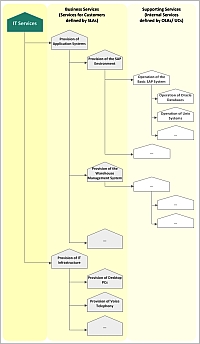ITIL Implementation - IT Service Structure
| diese Seite auf Deutsch |
|---|
Step 2: Definition of the Service Structure
Description
Business Services and Supporting Services
Any ITIL initiative should start by looking at services. After all, the whole idea behind introducing ITIL is to achieve a stronger focus on services.
The best way to get a clear picture on services is to develop a service structure, comprising both business and supporting services. This reflects one of the most important ITIL principles: Business services (offered to customers) are built from a set of supporting services (visible only inside the IT organization).
There is often confusion in IT organizations about what exactly is considered a business service: Business services are characterized by representing a direct value to customers, like e.g. the provision of e-mailing facilities and internet access.
Supporting services, in contrast, are not of direct value to customers but are needed as building blocks for business services. Providing a network infrastructure, for example, would be a supporting service which is required to offer internet access for customers.
In other words, what the customer wants is reliable internet access, not a specific sort of network infrastructure. (In fact it is irrelevant for the customer that a network infrastructure is needed to provide him with internet access).
Creating a List of Business Services
A good way to start is creating a list of existing business services, using – if possible – existing agreements and information. If no service-related information is available, a basic list must be drawn from scratch, including at least short service descriptions and customers using the services.
Determining Supporting Services
As soon as it is clear which business services are provided for the customers it becomes possible to identify the required supporting services.
The main point of defining supporting services is to assign responsibilities for the delivery of those services. The responsible Service Owners will thus be expected to make sure that their services meet the agreed service level targets.
Supporting services are often closely related to certain parts of the IT infrastructure, like e.g. major application systems or infrastructure components: “Providing the SAP environment” would be a typical example.
Defining the Service Structure

Having identified business and supporting services, the remaining task is to create the service structure by determining their interrelationships (see figure "IT Service Structure - Example").
It can be seen that supporting services are often layered; for example, a service responsible for running a certain application system may need to rely on another supporting service providing a basic operation system environment.
This service structure will later also serve as a valuable input to designing the Service Catalogue.
Objectives of this Project Step
- Identification of business and supporting services
- Creating the service structure by determining the interdependencies between business and supporting services
Prerequisites
- Existing agreements and information
- Partners on the client-side for the definition of business services
Results/ Deliverables
- List of business services, including at least short service descriptions and customers using the services
- List of supporting services, including at least short service descriptions and responsible Service Owners
- Service structure
Success Factors
- The actual signing of formal SLAs with the clients is not yet meaningful in this early project phase: SLAs are concluded within the framework of Service Level Management – a process which will be implemented later on in the course of the project.
- For most IT organizations, a number of approx. 5 to 15 business services should be adequate. The service structure will typically combine bundles of related service components into business services, in order to be able to ne-gotiate complete packages with the client and simultaneously spare him from having to consider technical details: In this way for example, a service called "Provision of Client PCs" may contain
- initial installation
- troubleshooting
- user assistance
- software updates
- hardware updates
- etc.
- The IT Service structure to be defined can only be viable if it is created in close co-ordination with the IT organization's clients. During the initial talks with the client-side, the IT representatives should emphasize their aim to improve service quality as the motivation for the initiative. The false impression that a possibly disadvantageous contract shall be forced onto the client must be avoided.
- Internal services need to be structured in such a way that it is possible to assign clear responsibilities to Service Owners. OLAs are later agreed with these Service Owners.
Following Process Activity






